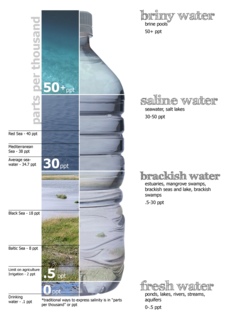
Back بحيرة مالحة Arabic Llagu saláu AST Mineral göl Azerbaijani Soizsä BAR Мінеральнае возера Byelorussian Солено езеро Bulgarian Llac salat Catalan Slané jezero Czech Saltsø Danish Salzsee German
This article needs additional citations for verification. (October 2019) |
| Part of a series on |
| Water salinity |
|---|
 |
| Salinity levels |
|
Fresh water (< 0.05%) Brackish water (0.05–3%) Saline water (3–5%) Brine (> 5% up to 26%–28% max) |
| Bodies of water |

A salt lake or saline lake is a landlocked body of water that has a concentration of salts (typically sodium chloride) and other dissolved minerals significantly higher than most lakes (often defined as at least three grams of salt per liter).[1] In some cases, salt lakes have a higher concentration of salt than sea water; such lakes can also be termed hypersaline lake, and may also be pink lakes on account of their color. An alkalic salt lake that has a high content of carbonate is sometimes termed a soda lake.[2]
One saline lake classification differentiates between:
- subsaline: 0.5–3‰ (0.05-0.3%)[2]
- hyposaline: 3–20‰ (0.3-2%)[2]
- mesosaline: 20–50‰ (2-5%)[2]
- hypersaline: greater than 50‰ (5%)[2]
- Large saline lakes make up 44% of the volume and 23% of the area of lakes worldwide[2]
- ^ "Physical Characteristics of Great Salt Lake". learn.genetics.utah.edu. Retrieved 2024-11-16.
- ^ a b c d e f Hammer, U. T. (1986-04-30). Saline Lake Ecosystems of the World. Springer Science & Business Media. ISBN 978-90-6193-535-3.